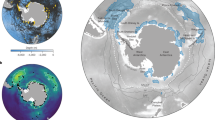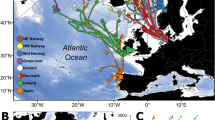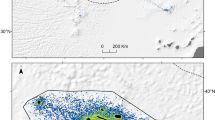Conservation efforts should focus on hot spots frequented by these ancient reptiles.
Abstract
The dramatic worldwide decline in populations of the leatherback turtle (Dermochelys coriacea)1 is largely due to the high mortality associated with their interaction with fisheries2, so a reduction of this overlap is critical to their survival. The discovery of narrow migration corridors used by the leatherbacks in the Pacific Ocean3 raised the possibility of protecting the turtles by restricting fishing in these key areas. Here we use satellite tracking to show that there is no equivalent of these corridors in the North Atlantic Ocean, because the turtles disperse actively over the whole area. But we are able to identify a few ‘hot spots’ where leatherbacks meet fisheries and where conservation efforts should be focused.
This is a preview of subscription content, access via your institution
Access options
Subscribe to this journal
Receive 51 print issues and online access
$199.00 per year
only $3.90 per issue
Buy this article
- Purchase on Springer Link
- Instant access to full article PDF
Prices may be subject to local taxes which are calculated during checkout

J.-Y. Georges

Similar content being viewed by others
References
Spotila, J. R. et al. Chelon. Conserv. Biol. 2, 209–222 (1996).
Hays, G. C., Broderick, A. C., Godley, B. J., Luschi, P. & Nichols, W. J. Mar. Ecol. Progr. Ser. 262, 305–309 (2003).
Morreale, S. J., Standora, E. A., Spotila, J. R. & Paladino, F. V. Nature 384, 319–320 (1996).
Bleakney, J. S. Can. Field Nat. 79, 120–128 (1965).
Podesta, G. P., Browder, J. A. & Hoey, J. J. Cont. Shelf Res. 13, 253–277 (1993).
Laurs, R. M., Fielder, P. C. & Montgomery, D. R. Deep-Sea Res. 31, 1085–1099 (1984).
Lewison, R. L., Freeman, S. A. & Crowder, L. B. Ecol. Lett. 7, 221–231 (2004).
Fonteneau, A. Atlas of Tropical Tuna Fisheries (Orstom, Paris, 1997).
Guéguen, F. C. R. Acad. Sci. Paris Sciences de la Vie 323, 775–791 (2000).
Ferraroli, S., Le Maho, Y. & Georges, J.-Y. C. R. Acad. Sci. Paris, Rapport sur la Science et la Technologie 17, 319–328 (2003).
Author information
Authors and Affiliations
Corresponding author
Ethics declarations
Competing interests
The authors declare no competing financial interests.
Supplementary information
Rights and permissions
About this article
Cite this article
Ferraroli, S., Georges, JY., Gaspar, P. et al. Where leatherback turtles meet fisheries. Nature 429, 521–522 (2004). https://doi.org/10.1038/429521a
Issue Date:
DOI: https://doi.org/10.1038/429521a
This article is cited by
-
First documented record of the leatherback turtle (Dermochelys coriacea) from Djibouti waters
Marine Biodiversity Records (2021)
-
Facing extremes: Cory’s shearwaters adjust their foraging behaviour differently in response to contrasting phases of North Atlantic Oscillation
Regional Environmental Change (2020)
-
Evaluating outcomes of long-term satellite tag attachment on leatherback sea turtles
Animal Biotelemetry (2018)
-
Reliance of mobile species on sensitive habitats: a case study of manta rays (Manta alfredi) and lagoons
Marine Biology (2014)
-
Spatial patterns in the diversity of sharks, rays, and chimaeras (Chondrichthyes) in the Southwest Atlantic
Biodiversity and Conservation (2012)
Comments
By submitting a comment you agree to abide by our Terms and Community Guidelines. If you find something abusive or that does not comply with our terms or guidelines please flag it as inappropriate.



